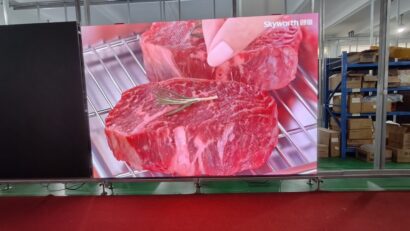From the perspective of phenomena, the “mosaic” phenomenon of LED display screens is manifested as inconsistent display surface brightness in different areas, that is, poor uniformity.

The fundamental reason for mosaic is the consistency of the lamp itself and the consistency defects in use.
LED modules are products that arrange LEDs (light-emitting diodes) according to certain rules, then encapsulate them together, and then add some waterproof treatments.
The main view surface of the quadrilateral module can be provided with a decorative structure to blur the splicing boundary of the module.
LED COB light source LED surface light source The utility model makes straight lines form staggered short lines from a visual and optical perspective.
Using the linearity of vision, human vision cannot take into account two staggered lines at the same time when scanning up and down (or moving left and right), and countless staggered discontinuous short lines will inevitably be formed.
Thereby completely eliminating the mosaic phenomenon caused by the gaps between modules on the LED display screen.
LED modules are widely used in LED products, and there are also great differences in structure and electronics.
In simple terms, it is to use a circuit board and a shell with LED to form an LED module, and add some controls on the complex basis.
Constant current source and related heat dissipation make LED life and luminous intensity better.
How to solve the mosaic phenomenon of full-color LED display?
Usually we only need to replace a module, but if we want to repair the mosaic phenomenon caused by this LED module, we can only return it to the factory for repair.
The specific reasons are as follows:
The same batch of red, green and blue LED lights are used on each LED display manufacturer, and the red, green and blue colors of this batch of LED lights are reclassified.
For constant current devices, inter-chip classification is performed, which is divided into 5 grades in total, and the constant current source of each grade is evenly distributed to the entire screen for LED unit board production.
Use standard production fixtures to ensure that the LED lights are in the same balanced position in the same module.
Control the mold manufacturing process to ensure that all LED lights in the module are not abnormally offset horizontally, up and down, and front and back. After the glue is filled, fix the light with a standard front cover.
Each LED unit board performs single module brightness adjustment, that is, white balance fine-tuning, to ensure uniform white balance between modules.
Assemble the modules into a cabinet. The cabinet adopts a steel plate rib structure, and reinforced ribs are added at appropriate positions.
Ensure the rigidity and flatness of the cabinet plane.
The cabinet is stamped and bent using CNC equipment in one step, and a CNC punching machine is used to ensure the accuracy of module installation.
There is an appropriate margin to eliminate cumulative errors.




